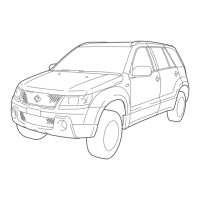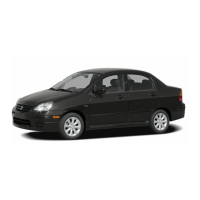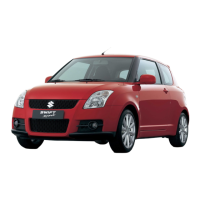Do you have a question about the Suzuki 2007 Aerio and is the answer not in the manual?
Details on approved gasoline types, oxygenated fuels, and labeling.
Information on vehicle keys, identification number, and ignition key reminder.
Instructions for locking and unlocking doors manually and with keyless entry.
Operation of power windows, including auto-down feature and child lock.
Adjustment and use of inside and outside rearview mirrors, including night position.
Procedures for adjusting front seat position, seatback angle, and head restraints.
Proper adjustment of head restraints to reduce neck injury risk in accidents.
Guidelines for proper seat belt use, including lap-shoulder belts and child restraint installation.
Explanation of front and side airbags, pretensioners, and system operation.
Operation of the ignition switch for manual and automatic transaxle vehicles.
Controls for lights, turn signals, and daytime running lights.
Operation of windshield wipers and washers, including intermittent control.
Operation of the rear window wiper and washer.
Adjustment of steering wheel height and locking mechanism.
How to set, change, and cancel cruise control operation for maintaining speed.
Using steering wheel controls to operate the audio system.
Location and operation of the horn.
Identification of main components on the instrument panel.
Description of gauges, indicators, and warning lights in the instrument cluster.
Explanation of various warning and indicator lights on the instrument panel.
Function and operation of the DRL indicator light.
Display of the automatic transaxle gearshift lever position.
Reading vehicle speed, total distance, and trip meter.
Adjusting the brightness of the instrument panel lights.
Indicates engine speed in revolutions per minute.
Indicates the amount of fuel in the fuel tank.
Indicates engine coolant temperature.
Operation of hazard warning lights for emergency situations.
Clearing fog from the rear window.
Clearing fog from the outside rearview mirrors.
Operation of the front fog lights.
Location and use of the cigarette lighter and ashtray.
Shows clock, thermometer, airbag status, and seat belt reminders.
Location and operation of the glove box.
Overview of the HVAC system and its components.
Description of audio system types, basic operations, and handling of CDs.
Procedure for setting and releasing the parking brake.
Location and function of clutch, brake, and accelerator pedals.
Operation of gearshift levers for manual and automatic transaxles.
Procedure for opening and closing the fuel filler cap.
Steps for folding the rear seatbacks forward.
Adjustment and use of the armrest.
Use of sun visors to block glare.
Operation of interior lights based on door status.
Operation of the spot lights.
Location and function of assist grips for passenger convenience.
Location and use of coat hooks.
Use of the eyeglasses holder.
Procedure for opening and closing the engine hood.
Location and use of cup holders and storage areas.
Powering electrical accessories using the 12V socket.
Location and use of frame hooks for emergency situations.
Location and use of tools for changing a tire.
Use of the front seat back pocket for storing items.
Operation of the trunk light.
Precautions to prevent carbon monoxide entering the vehicle.
Pre-drive checks to ensure vehicle safety and proper operation.
Procedures for starting a cold or warm engine, and troubleshooting.
Using the block heater for easier engine starting in very cold weather.
Operation of the 4-speed automatic transaxle and its modes.
Information on braking system, power assistance, ABS, and stopping distances.
Precautions for the initial period of vehicle operation to ensure engine reliability.
Function and maintenance of the catalytic converter.
Tips for maximizing fuel efficiency through driving habits and maintenance.
Tips for safe driving at high speeds, including hydroplaning and side winds.
Techniques for climbing and descending hills, including proper gear selection.
Advice for driving safely on wet, icy, or muddy roads, and handling stuck vehicles.
Understanding weight capacities (GVWR, GAWR, Vehicle Capacity Weight) and load distribution.
Information regarding towing trailers with the vehicle.
Proper methods for towing the vehicle behind another vehicle.
Recommended intervals for regular vehicle maintenance.
Detailed schedule for inspections, replacements, and lubrication based on mileage.
Adjusted maintenance intervals for vehicles operated in severe conditions.
Procedures for checking, changing, and replacing engine oil and filter.
Specified types of gear oil and level checking procedures.
Checking and maintaining automatic transaxle fluid level.
Selection, checking, and replacement of engine coolant.
Checking and refilling windshield washer fluid.
Inspecting and replacing the air cleaner element.
Inspecting and replacing spark plugs.
Checking brake fluid level and brake pedal operation.
Checking steering wheel play and operation.
Checking clutch pedal operation and fluid level.
Information on tire maintenance, including size, pressure, inspection, and rotation.
Maintenance of the vehicle battery, including checking terminals and condition.
Location and types of fuses, and procedures for replacement.
Recommendation to visit a dealer for headlight alignment.
Procedures for replacing various bulbs, including interior and exterior lights.
Procedures for replacing windshield wiper blades.
Maintenance recommendations for the air conditioning system.
Step-by-step guide on how to safely jack up the vehicle.
Procedure for safely jump starting a vehicle with a dead battery.
Methods for towing a disabled vehicle, including truck towing.
Troubleshooting steps when the starter does not engage.
Procedure for starting an engine that may be flooded with gasoline.
Steps to take if the engine overheats, including checking coolant.
Emergency procedure to shift out of Park if the battery is dead or electrical failure occurs.
Instructions and tips to prevent vehicle corrosion from road salt, dirt, and environment.
Procedures for cleaning the vehicle's interior and exterior, including washing and waxing.
Location of Vehicle Identification Number (VIN) and Engine Serial Number.
Information on the safety certification label regarding vehicle safety.
Information provided by the EPA emission compliance label under the hood.
Overview of vehicle warranties explained in a separate booklet.
How vehicle computers monitor performance and record data, including crash events.
Procedures for reporting vehicle safety defects to NHTSA and Suzuki.
Identification and location of fuses in the engine compartment fuse box.
Identification and location of fuses located under the dashboard.
Vehicle dimensions including length, width, height, wheelbase, and tread.
Information on axle weight ratings and vehicle capacity weight.
Engine specifications including type, displacement, bore, stroke, and compression ratio.
Electrical specifications including ignition timing, spark plugs, battery, and fuses.
Details on exterior and interior lights, including wattage and bulb numbers.
Tire size, front and rear, and tire pressure information.
Steering specifications including toe, camber, and caster angles.
Fluid capacities for coolant, fuel, engine oil, transaxle, differential, and transfer case.
Information on recommended fuel types for the vehicle.
Guidance on recommended engine oil viscosity and API service symbol.
Recommended brake and clutch fluid type.
Recommended automatic transaxle fluid type.
Recommended cold tire inflation pressures for safe operation.
Details on approved gasoline types, oxygenated fuels, and labeling.
Information on vehicle keys, identification number, and ignition key reminder.
Instructions for locking and unlocking doors manually and with keyless entry.
Operation of power windows, including auto-down feature and child lock.
Adjustment and use of inside and outside rearview mirrors, including night position.
Procedures for adjusting front seat position, seatback angle, and head restraints.
Proper adjustment of head restraints to reduce neck injury risk in accidents.
Guidelines for proper seat belt use, including lap-shoulder belts and child restraint installation.
Explanation of front and side airbags, pretensioners, and system operation.
Operation of the ignition switch for manual and automatic transaxle vehicles.
Controls for lights, turn signals, and daytime running lights.
Operation of windshield wipers and washers, including intermittent control.
Operation of the rear window wiper and washer.
Adjustment of steering wheel height and locking mechanism.
How to set, change, and cancel cruise control operation for maintaining speed.
Using steering wheel controls to operate the audio system.
Location and operation of the horn.
Identification of main components on the instrument panel.
Description of gauges, indicators, and warning lights in the instrument cluster.
Explanation of various warning and indicator lights on the instrument panel.
Function and operation of the DRL indicator light.
Display of the automatic transaxle gearshift lever position.
Reading vehicle speed, total distance, and trip meter.
Adjusting the brightness of the instrument panel lights.
Indicates engine speed in revolutions per minute.
Indicates the amount of fuel in the fuel tank.
Indicates engine coolant temperature.
Operation of hazard warning lights for emergency situations.
Clearing fog from the rear window.
Clearing fog from the outside rearview mirrors.
Operation of the front fog lights.
Location and use of the cigarette lighter and ashtray.
Shows clock, thermometer, airbag status, and seat belt reminders.
Location and operation of the glove box.
Overview of the HVAC system and its components.
Description of audio system types, basic operations, and handling of CDs.
Procedure for setting and releasing the parking brake.
Location and function of clutch, brake, and accelerator pedals.
Operation of gearshift levers for manual and automatic transaxles.
Procedure for opening and closing the fuel filler cap.
Steps for folding the rear seatbacks forward.
Adjustment and use of the armrest.
Use of sun visors to block glare.
Operation of interior lights based on door status.
Operation of the spot lights.
Location and function of assist grips for passenger convenience.
Location and use of coat hooks.
Use of the eyeglasses holder.
Procedure for opening and closing the engine hood.
Location and use of cup holders and storage areas.
Powering electrical accessories using the 12V socket.
Location and use of frame hooks for emergency situations.
Location and use of tools for changing a tire.
Use of the front seat back pocket for storing items.
Operation of the trunk light.
Precautions to prevent carbon monoxide entering the vehicle.
Pre-drive checks to ensure vehicle safety and proper operation.
Procedures for starting a cold or warm engine, and troubleshooting.
Using the block heater for easier engine starting in very cold weather.
Operation of the 4-speed automatic transaxle and its modes.
Information on braking system, power assistance, ABS, and stopping distances.
Precautions for the initial period of vehicle operation to ensure engine reliability.
Function and maintenance of the catalytic converter.
Tips for maximizing fuel efficiency through driving habits and maintenance.
Tips for safe driving at high speeds, including hydroplaning and side winds.
Techniques for climbing and descending hills, including proper gear selection.
Advice for driving safely on wet, icy, or muddy roads, and handling stuck vehicles.
Understanding weight capacities (GVWR, GAWR, Vehicle Capacity Weight) and load distribution.
Information regarding towing trailers with the vehicle.
Proper methods for towing the vehicle behind another vehicle.
Recommended intervals for regular vehicle maintenance.
Detailed schedule for inspections, replacements, and lubrication based on mileage.
Adjusted maintenance intervals for vehicles operated in severe conditions.
Procedures for checking, changing, and replacing engine oil and filter.
Specified types of gear oil and level checking procedures.
Checking and maintaining automatic transaxle fluid level.
Selection, checking, and replacement of engine coolant.
Checking and refilling windshield washer fluid.
Inspecting and replacing the air cleaner element.
Inspecting and replacing spark plugs.
Checking brake fluid level and brake pedal operation.
Checking steering wheel play and operation.
Checking clutch pedal operation and fluid level.
Information on tire maintenance, including size, pressure, inspection, and rotation.
Maintenance of the vehicle battery, including checking terminals and condition.
Location and types of fuses, and procedures for replacement.
Recommendation to visit a dealer for headlight alignment.
Procedures for replacing various bulbs, including interior and exterior lights.
Procedures for replacing windshield wiper blades.
Maintenance recommendations for the air conditioning system.
Step-by-step guide on how to safely jack up the vehicle.
Procedure for safely jump starting a vehicle with a dead battery.
Methods for towing a disabled vehicle, including truck towing.
Troubleshooting steps when the starter does not engage.
Procedure for starting an engine that may be flooded with gasoline.
Steps to take if the engine overheats, including checking coolant.
Emergency procedure to shift out of Park if the battery is dead or electrical failure occurs.
Instructions and tips to prevent vehicle corrosion from road salt, dirt, and environment.
Procedures for cleaning the vehicle's interior and exterior, including washing and waxing.
Location of Vehicle Identification Number (VIN) and Engine Serial Number.
Information on the safety certification label regarding vehicle safety.
Information provided by the EPA emission compliance label under the hood.
Overview of vehicle warranties explained in a separate booklet.
How vehicle computers monitor performance and record data, including crash events.
Procedures for reporting vehicle safety defects to NHTSA and Suzuki.
Identification and location of fuses in the engine compartment fuse box.
Identification and location of fuses located under the dashboard.
Vehicle dimensions including length, width, height, wheelbase, and tread.
Information on axle weight ratings and vehicle capacity weight.
Engine specifications including type, displacement, bore, stroke, and compression ratio.
Electrical specifications including ignition timing, spark plugs, battery, and fuses.
Details on exterior and interior lights, including wattage and bulb numbers.
Tire size, front and rear, and tire pressure information.
Steering specifications including toe, camber, and caster angles.
Fluid capacities for coolant, fuel, engine oil, transaxle, differential, and transfer case.
Information on recommended fuel types for the vehicle.
Guidance on recommended engine oil viscosity and API service symbol.
Recommended brake and clutch fluid type.
Recommended automatic transaxle fluid type.
Recommended cold tire inflation pressures for safe operation.
| Brand | Suzuki |
|---|---|
| Model | 2007 Aerio |
| Category | Automobile |
| Language | English |












